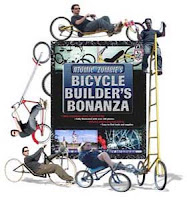Building the Highlander Chopper
from the Atomic Zombie Extreme Machines archives 2004
Highlander is a chopper based on those wild chops from the past - you know like the movie "Easy Rider"? Armed with nothing more than a photo from the move, a few bits of conduit and a hacksaw I began cutting things up and laying out the frame on the living room carpet - something you do when it's too cold to work in an unheated garage during the boring winter months. Highlander turned out so well, that it also earned a spot in my book under the chapter "The Infamous Chopper".
The rear of the frame is made by cutting the dropouts from one pair of front forks, then welding them another set . Both sets of forks are widened before hand in order to take a rear wheel - this is a delicate and precise operation that involves grunting like a rabid ape as you stand one one leg of the forks while pulling the other leg apart.
Bottom bracket salvaged from an old BMX bike - a busy intersection where the chain stay tube, seat tube and down tubes all meet. The entire frame is made from 1 inch thin walled electrical conduit.
Gussets not only give the frame some character, but also add needed strength to the junction between the down tube and top tube. This area will be under a lot of stress due to the ridiculous angle of the head tube.
Four foot long chopper forks - made from 1 inch thin walled electrical conduit. A nut is welded into the top end of each fork leg so that they can be bolted to the triple tree as you will soon see.
The two fork legs are welded directly to the bottom half of the triple tree. The threaded for tube is then welded to this plate. All of this is done with the front wheel in place to ensure proper alignment.
The top of the triple tree is bolted to the tops of each fork leg and also held in place by the fork stem. This system is designed much like a typical motorcycle triple tree setup. Simple, yet effective.
A big phat seat is mounted to the frame by welding the suspension part of the seat to the frame, then installing the seat back onto it. A big old exercise bike seat is a good candidate for this. You could also steal the seat from Grampa's old balloon tire cruiser - you know, the one buried deep in the back of the shed under the crates of 8-track tapes?
What would a chopper be without a nice styling rear fender? Some thin sheet metal is used to cut out the three pieces that make up the rear fender. Just tie a marker to a string that is slightly longer then the radius of the rear wheel and tire, then draw out the shape. This metal can be cut with a jigsaw.
The rear fender is tacked together and taking shape. Later, the entire seam is welded and ground so that it looks perfectly smooth with no weld makes or blemishes. Patience!
The rear fender is welded directly to the seat stays. Proper alignment is quite a chore, and the hammer flew across the garage in a fit of rage on more than one occasion before this step was complete!
Once I had the fender welded to the frame, and the front forks completed, it was off the the paint shop. Nope, that's not a $500 dollar powder coat - its a $5 can of spray paint.
An old-skool chopper must have a set of overly long ape hangers installed, or it would be breaking form. The handle bars are installed into a standard gooseneck just as they would be on a regular bike.
Highlander is one Phat chop! Not bad for two days work and ten bucks worth of parts!
The Highlander takes some getting used to, but rides well once you get the hang of it. The reclined position is actually quite comfortable, but don't ever admit that to anyone - choppers are supposed to be painful and hard to ride!
Yes, on a chopper like the Highlander, you do own the road!
Designed, photographed and written by Brad Graham (RadicalBrad), AtomicZombie.com















































